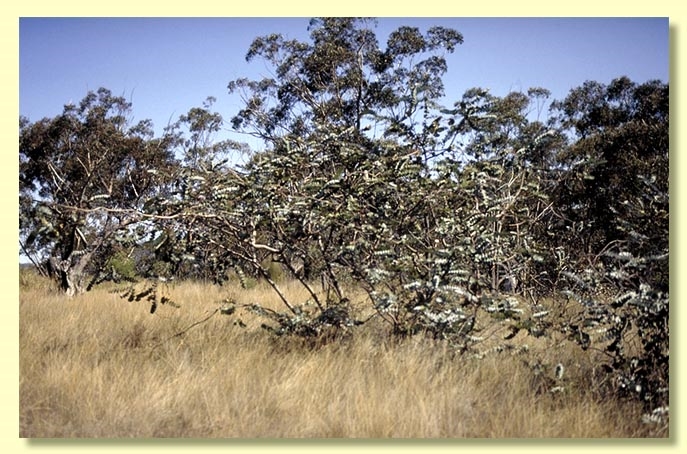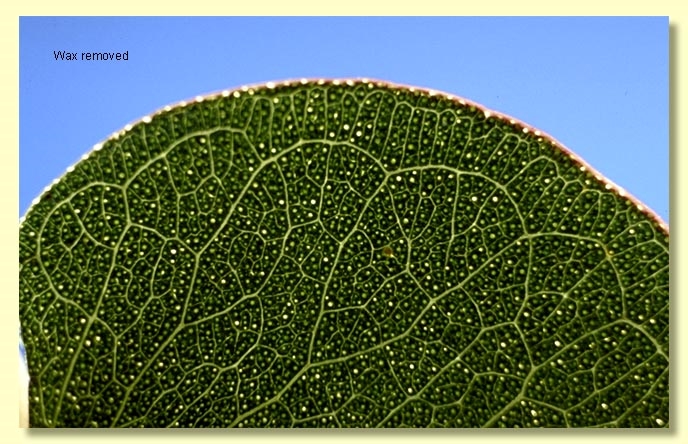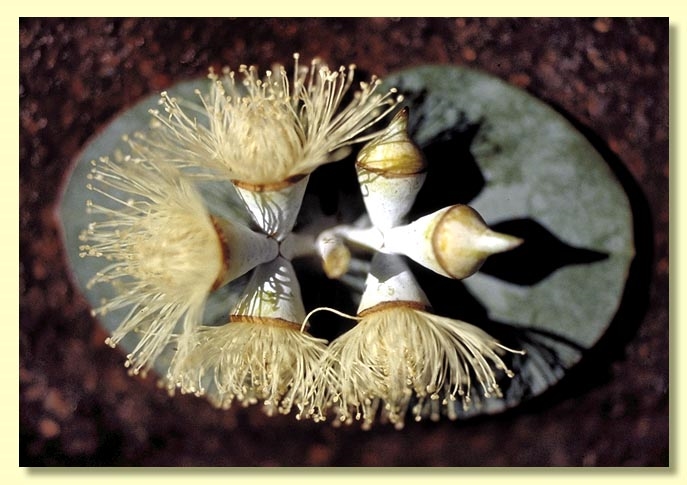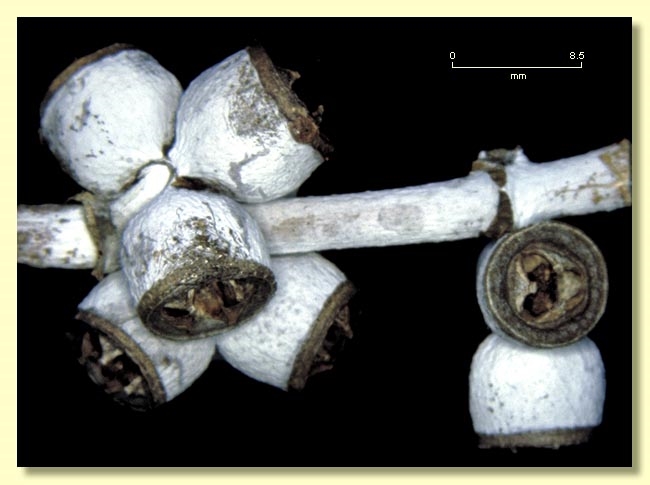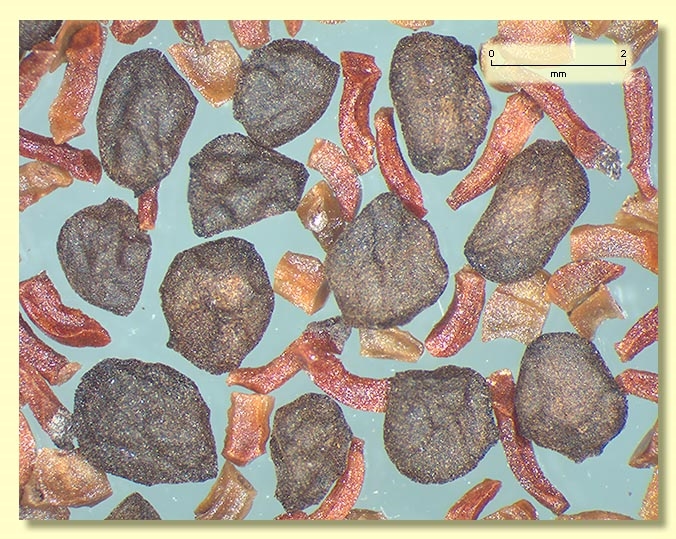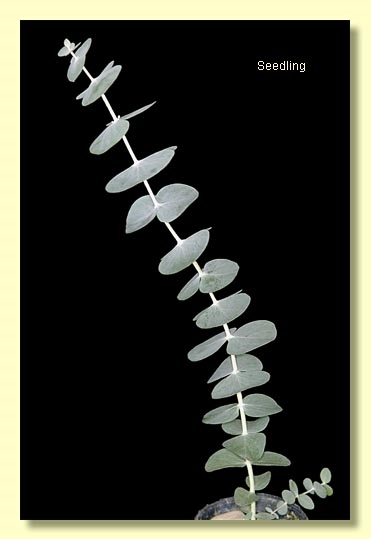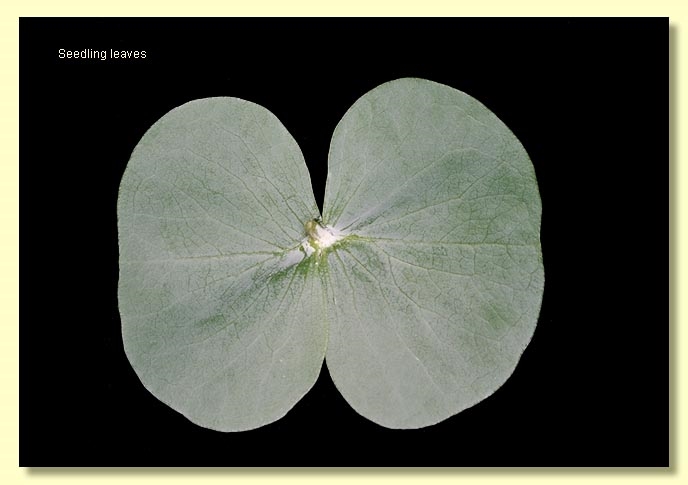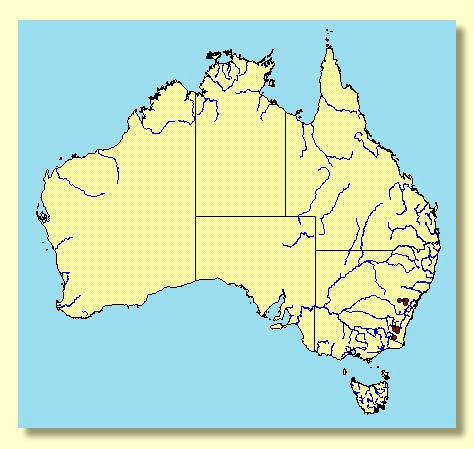Euclid - Online edition
Eucalyptus pulverulenta
Eucalyptus | Symphyomyrtus | Maidenaria | Euryotae | Orbiculares
T: cultivated Northampton Nursery, England, Messrs. Barr & Brookes s.n.; herbarium of type specimen not known to us.
Eucalyptus cordata Lodd., Bot. Cab. 4: t: 328 (1819); nom. illeg. non Labill. (1806). T: Van Diemens Land [Tas.]; herbarium of type specimen not known to us.
Eucalyptus pulvigera Cunn. in B.Field, Geogr. Mem. New South Wales 350 (1825). T: near Coxs R., NSW, Oct. 1822, A.Cunningham 57: holo: K; iso: BM.
Bark smooth throughout or with some short thin persistent ribbons at base of old trunks; smooth bark green to grey with brown, coppery or yellow patches; branchlets glaucous.
Juvenile growth (coppice or field seedlings to 50 cm): stem rounded in cross-section, glaucous; juvenile leaves opposite and sessile from seedling through to reproductive crown, orbicular to ovate or almost cordate, 1.5–5 cm long, 2–5 cm wide, base lobed, truncate or rounded, apex pointed, rounded or rarely shallowly emarginate, glaucous.
Crown usually entirely of juvenile leaves (see above for description of these). Adult leaves very rarely produced, petiolate, alternate with blade oblong to lanceolate to 10 cm long, 2 cm wide, usually glaucous, side-veins greater than 45° to midrib, moderately reticulate with island oil glands.
Inflorescence axillary unbranched, peduncles 0.3–1.2 cm long, buds 3 per umbel, sessile or on pedicels to 0.3 cm long. Mature buds ovoid to diamond-shaped, 0.9–1.1 cm long, 0.4–0.7 cm wide, conspicuously glaucous, scar present, operculum conical to beaked, stamens inflexed, anthers cuboid or globoid, versatile, dorsifixed, dehiscing by longitudinal slits (non-confluent), style long, stigma blunt or tapered, locules usually 3 or 4, the placentae each with 4, 6 or 8 vertical ovule rows. Flowers white.
Fruit sessile or on pedicels to 0.2 cm long, cup-shaped to cylindrical, 0.5–1 cm long, 0.6–1.1 cm wide, glaucous initially but weathering to non-glaucous, disc slightly raised, level or slightly descending, valves 3 or 4, exserted or near rim level.
Seeds dark brown to black, 1.3–2 mm long, ovoid or flattened-ovoid, lacunose, dorsal surface smooth, hilum ventral.
Cultivated seedlings (measured at ca node 10): cotyledons bilobed; stems rounded to square in cross-section, glaucous; leaves sessile, opposite for many pairs, orbicular to cordate, 1.5–4.5 cm long, 2–5.5 cm wide, base usually amplexicaul, rarely truncate, margin entire, apex rounded to emarginate, glaucous or blue-grey.
Flowering has been recorded in May, June, July, August, September, October and November.
Eucalyptus pulverulenta is often grown as a small ornamental.
A straggly small tree or mallee occurring in several disjunct populations from the western Blue Mountains west of Sydney, south in hills east of Bredbo and Cooma on the Southern Tablelands and near the Victorian border south-west of Bombala in far south New South Wales.
E. pulverulenta is easily recognised by the straggly habit, smooth bark and crown almost exclusively of orbicular to ovate, opposite, glaucous juvenile leaves. From a distance it may be confused with E. cinerea which is a taller tree and differs most conspicuously in the completely rough bark.
Eucalyptus pulverulenta belongs in Eucalyptus subgenus Symphyomyrtus section Maidenaria, a large group of species more or less restricted to south-eastern Australia, characterised by bilobed cotyledons, simple axillary inflorescences, buds with two opercula, stamens with versatile anthers and flattened seeds with a ventral hilum. Within this section, E. pulverulenta, with nine other species, forms series Orbiculares having orbicular to ovate juvenile leaves opposite for many nodes, a grey-green crown, and buds in threes. Series Orbiculares is confined to far south-eastern New South Wales, eastern Victoria and Tasmania.
Eucalyptus pulverulenta is listed as "Vulnerable" under the Australian Government Environment Protection and Biodiversity Conservation Act 1999 (EPBC Act). Further information may be found at this web address:
http://www.environment.gov.au/cgi-bin/sprat/public/sprat.pl

